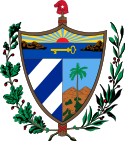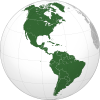- Constitution of Cuba
-
Cuba 
This article is part of the series:
Politics and government of
Cuba- Constitution
- Council of State
- First Vice President
- Second Vice President
- Cabinet (Council of Ministers)
- National Assembly of People's Power
- President
- Ricardo Alarcón de Quesada
- President
- Supreme Court
- Political parties
- Communist Party of Cuba
- First Secretary
- Communist Party of Cuba
- Elections: 2003, 2008
- Provinces
- Municipalities
- Committees for the Defense
of the Revolution - Opposition
- Human rights
- Foreign relations
Other countries · Atlas
Politics portal
Contents
1901 Constitution
Main article: 1901 Constitution of CubaThe 1901 Constitution was Cuba's first as an independent state. It contained the Platt Amendment, which allowed the United States to intervene in Cuba's affairs to protect its independence.[1]
The 1901 Constitution was indeed a carbon copy of the Constitution written at La Yara in 1896, and met with fierce opposition from its principal author Major General José Braulio Alemán who strongly opposed the Platt Amendment.[citation needed]
It was Alemán's contention that Cuba should be and remain "Libre y Soberana", Free and Sovereign; and that the Platt Amendment just traded Spain's strong arm tactics on the island for the yoke of American imperialism.[citation needed]
1934 Constitution
Cuba's second constitution came into effect in 1934. This document was intended to be a provisional constitution.
1940 Constitution
In 1940, during the de facto presidency of Fulgencio Batista, a constitution was created. It provided for land reform, public education, minimum wage and other progressive ideas. Some of its provisions were not implemented in practice. Following a coup d'etat by Fulgencio Batista in 1952, parts of this constitution were suspended.
Prior to the triumph of the Cuban Revolution, Fidel Castro and the other revolutionaries, through several documents, such as "History will absolve me" (1952) , the "Manifiesto de la Sierra",[2][3] etc. claimed that their chief goal was to reinstate the Constitution of 1940[citation needed], a promise which was never honored after their victory.
The last surviving signer of the 1940 Constitution, Emilio Ochoa, died in Miami, Florida, on 27 June 2007.[4]
1976 Constitution
After 16 years of extra-constitutional rule (1959–1975), used to consolidate its power, the revolutionary government of Cuba sought to institutionalize the revolution. The Socialist Constitution of 1976 was adopted by referendum on 15 February, in which it was approved by 97.7% of voters.[5] The document came into effect on 24 February 1976.
Original provisions
This constitution called for a centralized control of the market, and committed the State to providing its citizens with access to free education and health care. It also required that parents, regardless of their own beliefs, inculcate their children with socialist values. The state had the power to regulate the activities of religious institutions on the island, and the private ownership of media companies was forbidden.
Later amendments
In the late 1980s, as the Eastern Bloc collapsed, the laws of Cuba changed again to respond to the new conditions of the Special Period. The constitutional amendments of 1992 granted foreign corporations a limited right to own property on the island if they took part in joint ventures with the government. It also provided for non-discrimination based on religious belief (i.e., allowing persons with religious belief to join the Communist Party of Cuba).
In 2002, the Cuban Constitution was again amended to stipulate that its socialistic system was permanent and irrevocable.[6]
See also
References
- ^ Nohlen, D (2005) Elections in the Americas: A data handbook, Volume I, p195 ISBN 9780199283576
- ^ http://www.cedema.org/ver.php?id=3413
- ^ Revista Bohemia (Havana), July 28, 1957, pp. 69, 96-99
- ^ "Emilio Ochoa, signer of Cuba's 1940 constitution, dies at 99". Associated Press (International Herald Tribune). 2007-06-27. http://www.iht.com/articles/ap/2007/06/28/america/NA-GEN-US-Obit-Ochoa.php. Retrieved 2008-04-19.
- ^ Nohlen, p197
- ^ Nohlen, p199
External links
- Constitution of Cuba 1992 English language version
- Constitutions of Cuba Original Spanish language Text, by the Political Database of the Americas.
- CONSTITUCIÓN DE LA REPUBLICA DE CUBA Original Spanish language Text of 2002, by the Portal Cuba.
- REPUBLIC OF CUBA, 1940 Constitution in English translation from the original legal text.
- The Cuban Constitution of 1976, revised 1992
Constitutions of states and dependencies in the Americas - North America
- South America
Sovereign states - Antigua and Barbuda
- Argentina
- Bahamas
- Barbados
- Belize
- Bolivia
- Brazil
- Canada
- Chile
- Colombia
- Costa Rica
- Cuba
- Dominica
- Dominican Republic
- Ecuador
- El Salvador
- Grenada
- Guatemala
- Guyana
- Haiti
- Honduras
- Jamaica
- Mexico
- Nicaragua
- Panama
- Paraguay
- Peru
- Saint Kitts and Nevis
- Saint Lucia
- Saint Vincent and the Grenadines
- Suriname
- Trinidad and Tobago
- United States
- Uruguay
- Venezuela

Dependencies and
other territories- Anguilla
- Aruba
- Bermuda
- Bonaire
- British Virgin Islands
- Cayman Islands
- Curaçao
- Falkland Islands
- French Guiana
- Greenland
- Guadeloupe
- Martinique
- Montserrat
- Navassa Island
- Puerto Rico
- Saint Barthélemy
- Saint Martin
- Saint Pierre and Miquelon
- Saba
- Sint Eustatius
- Sint Maarten
- South Georgia and the South Sandwich Islands
- Turks and Caicos Islands
- US Virgin Islands
Categories:- Constitution of Cuba
- Politics of Cuba
- Government of Cuba
Wikimedia Foundation. 2010.
Look at other dictionaries:
1940 Constitution of Cuba — Cuba This article is part of the series: Politics and government of Cuba Constitution Council of State … Wikipedia
Cuba — Pour les articles homonymes, voir Cuba (homonymie). República de Cuba (es) … Wikipédia en Français
CUBA — L’île de Cuba, la plus grande de l’archipel des Caraïbes (110 922 km2), occupe une position stratégique à 77 km de Haïti et à 140 km de la Jamaïque. Longue de 1 200 km – alors que sa largeur varie de 32 à 145 km –, Cuba est très proche du… … Encyclopédie Universelle
CUBA — CUBA, archipelago of islands consisting of Cuba, Isla de Pinos, and 1,600 smaller islands; population (2004) 11,300,000; Jewish population (2004) approximately 1,200. The Colonial Period Columbus discovered Cuba during his first voyage (1492).… … Encyclopedia of Judaism
Cuba — • The largest and westernmost island of the West Indies Catholic Encyclopedia. Kevin Knight. 2006. Cuba Cuba † … Catholic encyclopedia
Constitution of Canada — This article is part of a series Constitutional history … Wikipedia
CUBA - Actualité (1990-1996) — P align=center République de Cuba Politique intérieure Le 10 octobre 1991 s’ouvre le IVe congrès du Parti communiste cubain à Santiago. Fidel Castro justifie le maintien d’une stricte orthodoxie marxiste dans l’île. Le 20 janvier 1992, Eduardo… … Encyclopédie Universelle
Constitution of Brazil — Constitution of the Federative Republic of Brazil The original copy of the Constitution Ratified … Wikipedia
Cuba — This article is about the country. For other uses, see Cuba (disambiguation). Republic of Cuba República de Cuba … Wikipedia
Cuba — Cuban, adj., n. /kyooh beuh/; Sp. /kooh vah/, n. a republic in the Caribbean, S of Florida: largest island in the West Indies. 10,999,041; 44,218 sq. mi. (114,525 sq. km). Cap.: Havana. /kooh bah/, n. Cubba. * * * Cuba Introduction Cuba… … Universalium
